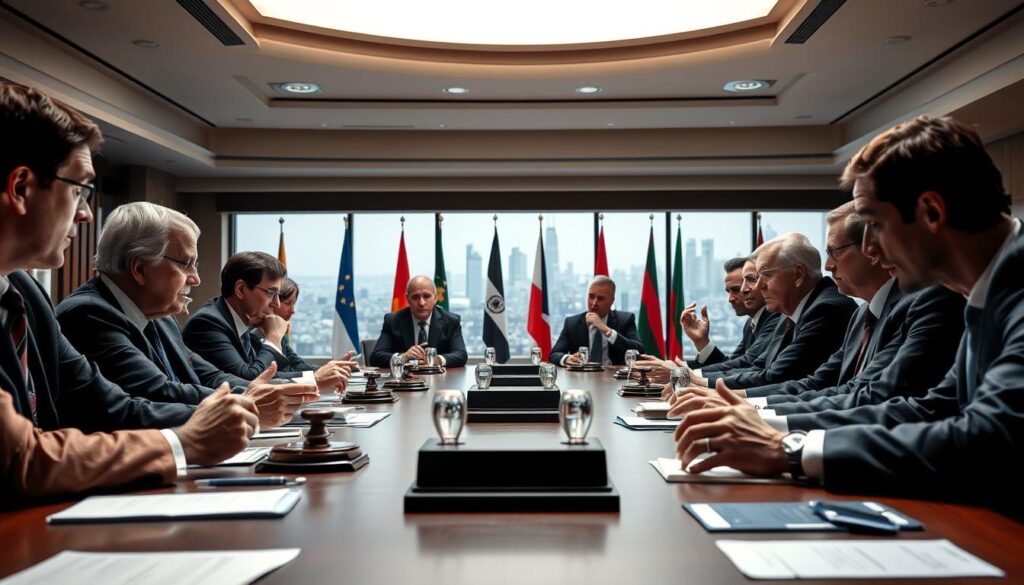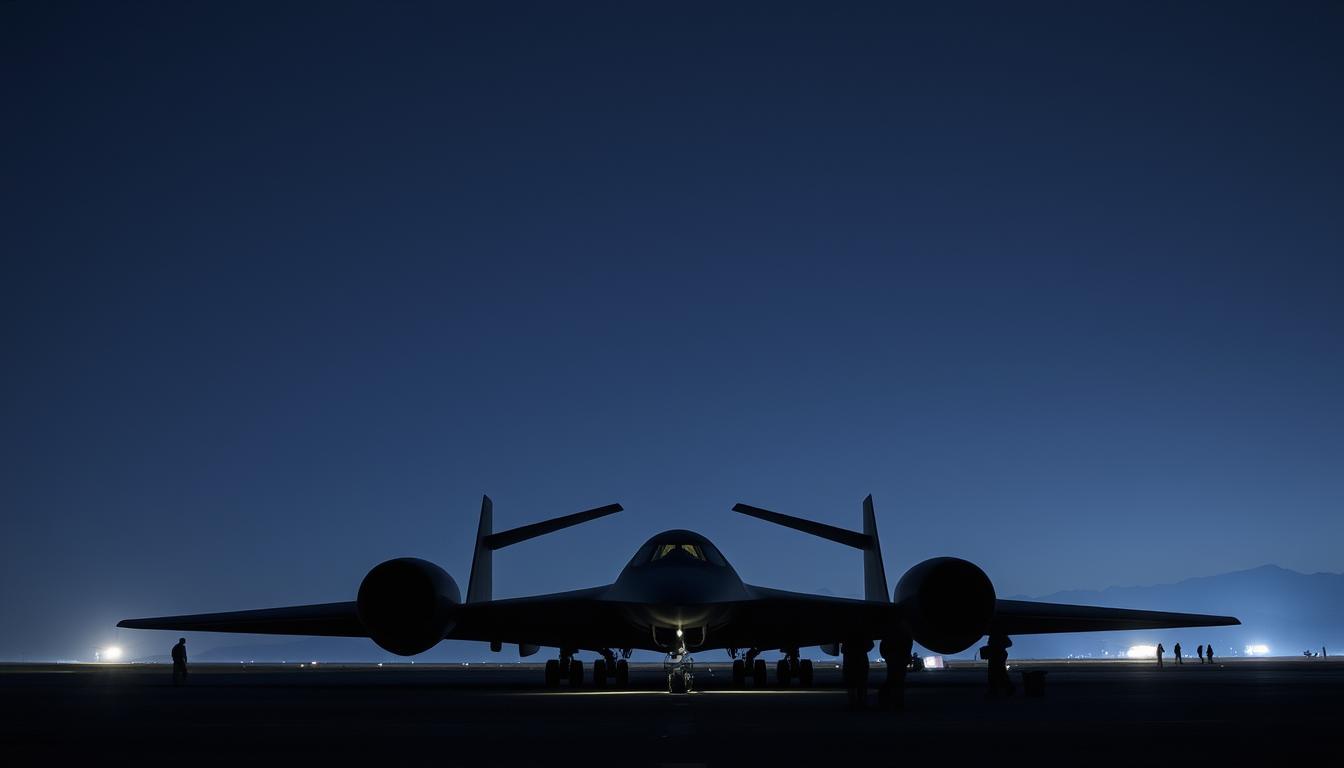A single mission dropped 180,000 pounds of specialized munitions across three hardened targets in 2025 – equivalent to destroying 45 school buses worth of concrete-piercing explosives. This unprecedented show of force marked America’s first direct military engagement in a simmering regional crisis, escalating tensions to historic levels.
The operation targeted facilities buried deeper than the Empire State Building’s height, requiring technology only one nation possesses. Military analysts called it “the ultimate test of precision warfare,” combining stealth aircraft with earth-shaking payloads designed to neutralize underground threats.
You’ll explore how this decisive action followed years of diplomatic stalemates. The strategy involved meticulous planning around geopolitical red lines while confronting a critical question: How does a superpower prevent nuclear proliferation without triggering wider conflict?
This event reshaped defense policies and alliance dynamics across continents. It demonstrated how advanced military capabilities could rewrite rulebooks on deterrence, while raising new debates about executive authority in crisis situations.
Key Takeaways
- A historic military operation utilized specialized aircraft to neutralize deeply buried nuclear facilities
- Strategic decisions involved balancing immediate security concerns with long-term regional stability
- Advanced munitions demonstrated new capabilities in precision underground targeting
- The action escalated ongoing tensions while aiming to prevent larger-scale warfare
- Critical infrastructure destruction led to immediate international policy repercussions
- Executive authority in military engagements became a renewed focus of political debate
Background of U.S. Military Involvement
The unraveling of a key international agreement in 2018 marked a turning point in global security strategies. This decision created ripple effects that would shape defense policies for years, blending diplomatic efforts with show-of-force tactics.
Historical Context and Foreign Policy
For decades, Middle Eastern engagements followed predictable patterns. Previous administrations prioritized multilateral agreements and gradual sanctions. One analyst noted:
“The old playbook relied on slow escalation – like turning a dial. New strategies punch buttons.”
This shift became clear through contrasting approaches to nuclear negotiations. The table below highlights key differences:
| Administration | Strategy | Duration | Focus |
|---|---|---|---|
| Obama | Multilateral deals | 6 years | Diplomatic containment |
| President Donald | Bilateral pressure | 2 months | Immediate concessions |
Previous Military Engagements
Earlier confrontations set important precedents. The 2017 standoff with North Korea demonstrated a pattern: public threats followed by backchannel negotiations. Similar tactics emerged during Middle Eastern tensions.
Diplomatic efforts preceded armed responses in most cases. High-level talks occurred for eight weeks before military options gained traction. Regional allies received assurances about proportional force usage during critical phases.
Domestic political factors also played roles. Congressional hearings and opinion polls influenced timing decisions. As one official stated, “Public support often determines when, not if, forces get involved.”
US B-2 bomber deployment Trump Iran conflict 2025
Strategic movements in the Pacific theater marked a pivotal shift in military operations during 2025. Advanced aircraft departed from domestic bases, crossing vast ocean distances to reach forward positions. This repositioning demonstrated a calculated approach to addressing emerging threats.
Deployment Details and Capabilities
The mission relied on specialized aircraft carrying 30,000-pound penetrator munitions. These weapons use sheer mass and velocity to burrow through reinforced structures before detonation. Experts noted multiple strikes could achieve depths exceeding 60 meters – crucial for neutralizing underground complexes.
Stealth technology proved vital for undetected approaches. One analyst told PBS News Hour:
“No other nation fields systems combining this level of precision with near-invisibility to radar.”
The operation required consecutive drops of kinetic-impact devices. Each successive blast amplified the destructive effect, creating layered impacts on fortified targets.
Connection to National Security Priorities
This decisive action reflected a broader strategy favoring immediate results over extended talks. Officials emphasized preventing nuclear proliferation through targeted strikes rather than diplomatic timelines. The approach addressed growing concerns about underground facilities becoming operational.
Military planners highlighted the difference uncertain times demand in response protocols. Rapid deployment capabilities showcased readiness to act when intelligence indicates imminent threats, aligning with stated security objectives.
Presidential Decision and Legal Authority
The legal boundaries of executive power faced intense scrutiny following recent military actions. Constitutional scholars highlight a delicate balance between swift national defense measures and collective legislative oversight. At the heart lies Article II’s grant of authority to protect American interests against immediate threats.
Article II Powers and Constitutional Debates
You’ll discover how the decision to authorize strikes relied on interpretations of presidential wartime authority. The Office of Legal Counsel emphasizes that brief engagements might not require congressional approval if deemed defensive. One expert told PBS News Hour:
“Executive actions hinge on perceived urgency – like stopping a ticking clock.”
Congressional Oversight and Resolutions
Lawmakers responded with bipartisan resolutions demanding stricter consultation rules. These measures sought to clarify when involvement crosses into war-making territory under Article I. Though unsuccessful, they revealed growing concerns about unchecked executive actions.
The debate continues as legal teams analyze strike durations and objectives. Some argue this decision sets precedents that could reshape future military engagements. Others warn it may draw criticism for bypassing traditional checks on presidential power.
Your support through news hour donation makes deeper analysis of these constitutional tensions possible. Understanding these frameworks helps citizens grasp how leaders navigate complex security challenges while respecting democratic processes.
International Law and Diplomatic Repercussions

Legal experts worldwide question whether recent military actions align with global governance frameworks. Over 300 international lawyers signed a declaration arguing such strikes breach the UN Charter’s foundational principles.
Legal Implications of Strikes on Nuclear Facilities
The UN’s rules only allow force in self-defense or with Security Council approval. Historical patterns matter here – in 1981, America joined others condemning a similar strike on Iraq’s nuclear site. One scholar noted:
“Preemptive attacks create dangerous precedents. They rewrite rules meant to prevent chaos.”
This situation highlights how security decisions test legal boundaries. Constitutional experts emphasize that even urgent threats require balancing immediate action with treaty obligations.
Global Reactions from Foreign Governments
European leaders scrambled to contain fallout. France’s president announced accelerated talks with Tehran, stating: “Dialogue remains our strongest shield against escalation.” Over 40 nations issued statements expressing concern.
Regional powers warned of chain reactions. A Middle Eastern diplomat shared anonymously: “When major countries act unilaterally, smaller states question the rules-based order.” This sentiment echoed through emergency UN sessions.
The strategy’s long-term impact becomes clearer daily. While addressing one threat, it risks eroding trust in multilateral systems that took decades to build. Your understanding of these tensions helps explain why global stability often hangs on delicate balances.
Media Coverage and Reporting Highlights
Newsrooms scrambled to decode the operation’s scale as details emerged. Outlets balanced technical analysis with ethical questions about wartime reporting. This coverage shaped public understanding through competing narratives and exclusive leaks.
Insights from the Council on Foreign Relations
The CFR’s breakdown clarified complex legal issues. Their experts questioned whether strikes against underground facilities met international standards for self-defense. One analyst stated:
“Preemptive actions demand extraordinary justification. The world watches how major powers interpret these rules during crises.”
Perspectives from Major News Outlets
Fox News aired exclusive battlefield details hours after the attacks. A prominent host revealed conversations about specific munitions used, claiming: “Six specialized penetrators hit priority targets with surgical precision.”
The New York Times tracked stealth aircraft movements through satellite imagery. Their maps showed flight paths avoiding detection zones, while critics argued this endangered operational security.
Social media fueled debates about accountability. Supporters praised decisive action to prevent war, while skeptics highlighted risks of escalating regional attacks. Independent journalists emphasized how public donation makes difference in maintaining diverse coverage during polarized moments.
Public Protests and Humanitarian Concerns
Global streets erupted with demands for peace as civilian suffering reached critical levels. Cities became stages for urgent calls to action, blending political dissent with desperate pleas for aid.
Demonstrations in Berlin and London
Over 10,000 voices filled Berlin’s streets chanting “Germany finances, Israel bombs.” Protesters held signs reading “Stop arming Israel” and “No war on Iran,” reflecting fears of expanding military actions. London saw similar marches, with crowds urging immediate ceasefire talks.
| Location | Focus | Key Messages | Participants |
|---|---|---|---|
| Berlin | Military funding | “End weapons transfers” | 10,000+ |
| London | Ceasefire demands | “Stop the attacks” | Tens of thousands |
| Gaza | Aid delivery | “Open corridors now” | N/A |
Aid Efforts in Regional Impact
The Gaza Humanitarian Foundation reported:
“Families haven’t eaten proper meals in a week.”
Relief groups struggle to deliver supplies through active combat zones. Meanwhile, 1,300 Berlin protesters separately demanded political changes in Tehran, showing divided public opinions.
UN officials warned current strategies could spark wider displacement, with 500,000 already facing food shortages. Your support for humanitarian groups becomes crucial as winter approaches and supply routes remain unstable.
Military Tactics and Strategic Moves
Modern warfare entered uncharted territory with groundbreaking weapon systems. The mission’s success relied on blending cutting-edge technology with precise execution, creating a blueprint for future engagements.
Role of Stealth Bombers and Bunker Buster Bombs
You might wonder how forces neutralize targets buried deeper than skyscrapers. The answer lies in the 30,000-pound GBU-57 – a penetrator bomb that combines mass with smart guidance systems. This tool shattered records by reaching depths exceeding 60 meters before detonation.
Stealth capabilities proved vital during approach phases. One PBS News Hour analyst noted: “These aircraft became shadows – present but unseen until their payloads spoke.” The combination of invisibility and firepower created unmatched tactical advantages.
Tactical Analysis of the Attack on Nuclear Sites
Three key facilities faced simultaneous precision strikes. Planners timed explosions to amplify shockwaves through underground networks. Each impact weakened structural integrity, allowing follow-up bombs to achieve maximum effect.
The strategy reflected lessons from past administrations. While not explicitly ordered by President Donald, the operation echoed his administration’s preference for decisive action against imminent threats. This approach balanced rapid response with careful target selection to minimize unintended consequences.
You see modern conflict’s evolution here – where advanced tools enable surgical attacks previously deemed impossible. Yet these capabilities raise new questions about proportionality and long-term security impacts that will shape defense debates for years.

